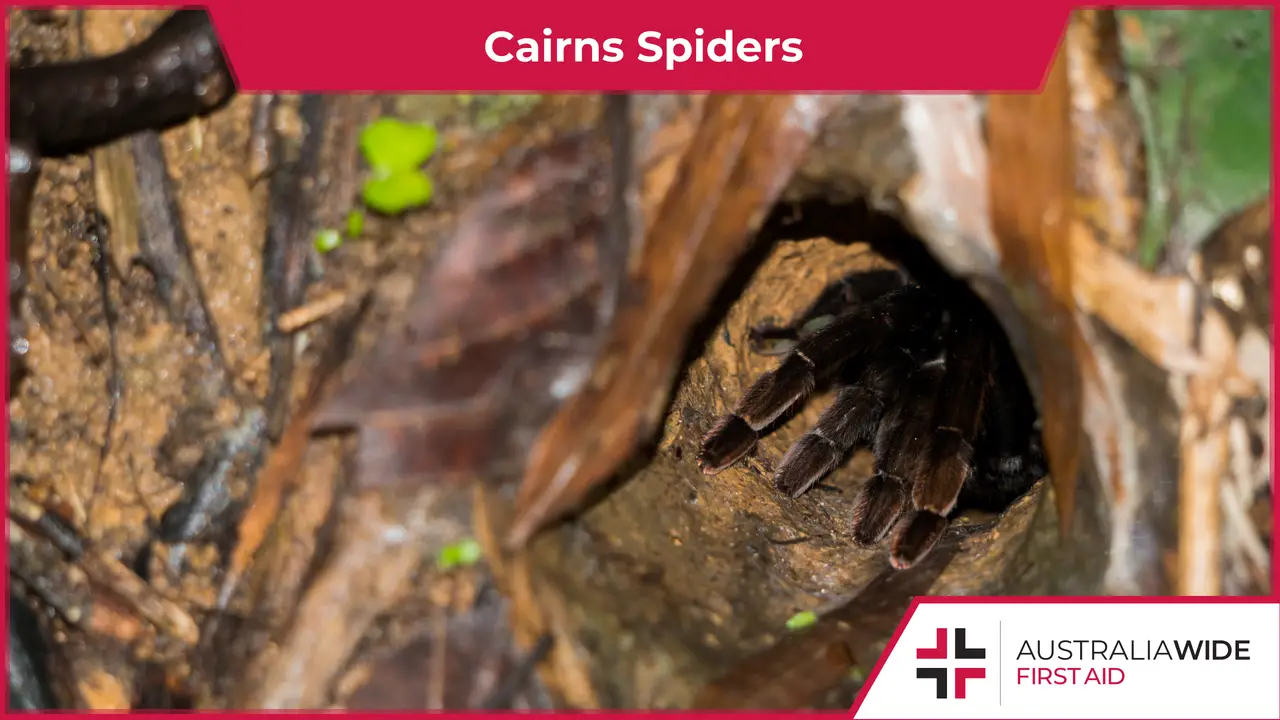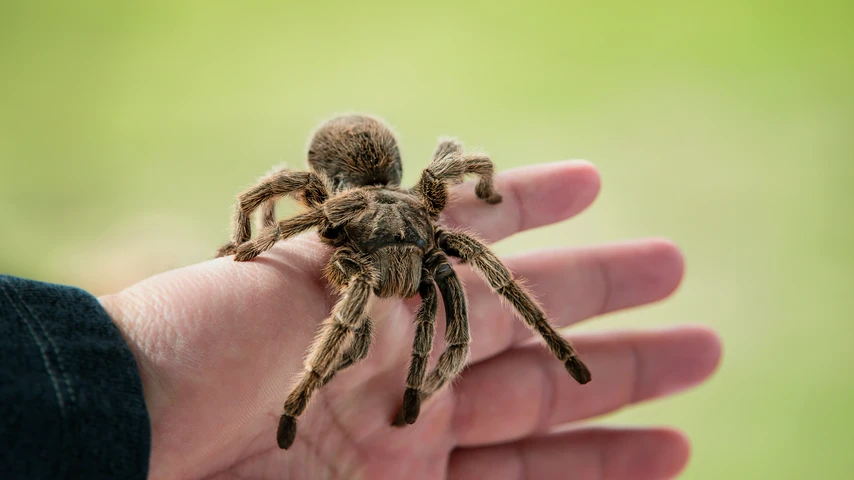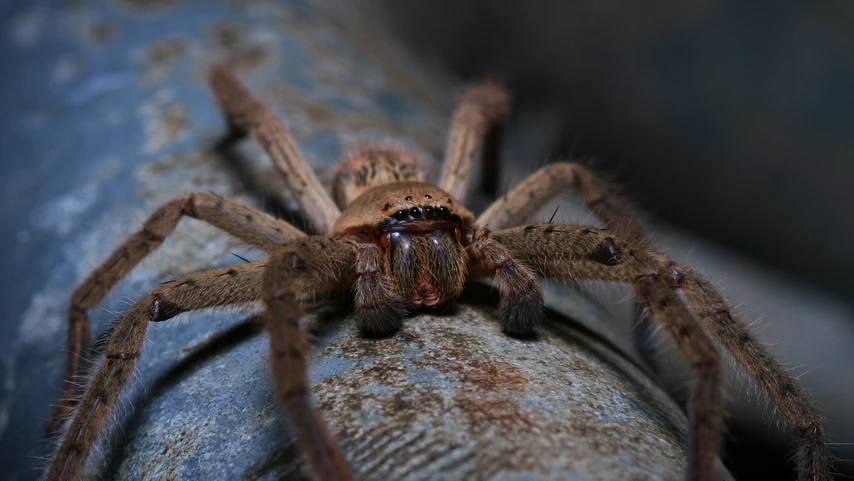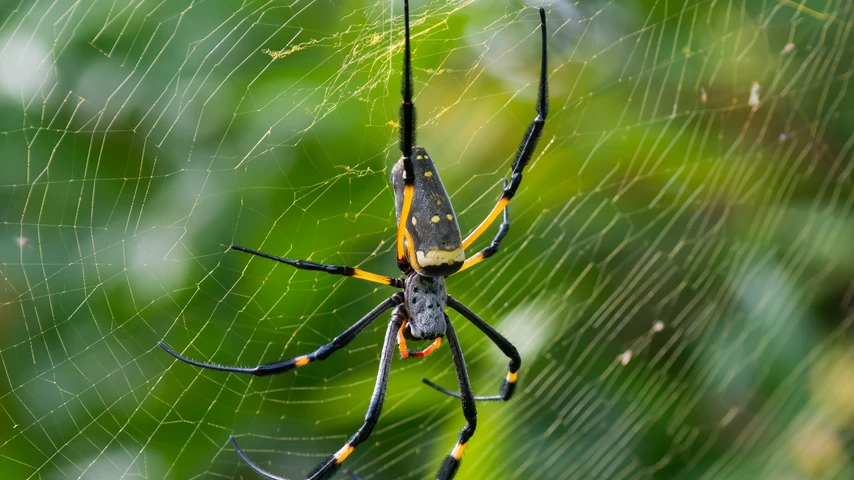A Guide to Cairns Spiders


The wet tropics of Northern Queensland are home to an abundant array of spiders appearing fearsome, toxic, and sometimes gruesome.
Australia is home to an estimated 10,000 spider species, of which less than a third have been described. It’s always best to leave spiders alone, if you want to identify a spider, for curiosity or because you have been bitten - take a photo.
Being familiar with the appearance and behaviour of these spiders will help you avoid bites while exploring or living in the tropics.
Read on to find out how to spot, treat a bite and marvel at the fascinating and cunning spiders common to Cairns, a major town in Northern Queensland.
We also cover spider bites in our following first aid courses:
We offer these courses in Cairns and in multiple over locations across Queensland - head to the relevant link to book now!

Primitive spiders are ancient creatures that evolved earlier on the evolutionary scale. They are characterised by their tendency to burrow into the ground and wait for their prey, then lunging out and grabbing their meal. Primitive spiders have large fangs accompanied by a large heavy set body.
The whistling spider, a type of tarantula, is one such common primitive spider in wet tropical areas like Cairns. They are also known as the bird-eating spider, more because they resemble a fluffy chick, rather than their tendency to eat birds. While there are records of whistling spiders dragging baby chickens from their nest, they tend to stick to their usual diet of large crawling insects, small reptiles and frogs. Australia’s tarantulas hiss, which gives them their name.
The whistling spider is usually straight black and brown and very hairy. It’s formidable in appearance and lives in sloping areas close to a water source. Whistling spiders can make open burrows that extend up to 2 metres long and 1 metre deep.
While venom from a whistling spider bite is fatal to dogs and cats, it rarely harms humans. If you believe you have been bitten by a whistling spider, take a photo for identification and follow our first aid procedure.

Ambush spiders are next on the evolutionary scale from primitive spiders. These spiders wander in order to find, hunt, and ambush their prey. Masters in deception, they wait unnoticed where insects will feed before pouncing on them.
They move quickly and tend to adapt into full disguise of their feeding environment. For this reason, they come in many different shapes, colours and sizes.
The huntsman is an ambush spider common to Cairns. Huntsman spiders are notorious for their speed and agility. With eight eyes, a dark hairy body, and whooping leg span of up to 15cm, huntsman can appear truly terrifying when encountered. Their legs bend forward like those of a crab, and they can move in any direction with great speed.
In wet or humid weather, huntsman like to use their flat body to hide and shelter in the nooks and crannies of homes and cars.
Huntsman are often described as natural insecticides, and will feed on many unwanted insects around the home - they particularly enjoy cockroaches.
Despite their fearsome appearance, huntsman spiders are largely harmless to humans and will not bite unless provoked.
In the event of a huntsman spider bite, consult this first aid procedure.

As insects evolved wings over time, spiders kept up with them by weaving webs. The silk we see in webs was first part of a spiders’ reproductive process. Silk is used by both male and females in protecting spider eggs, but also transferring sperm.
Weaver spiders have various and elaborate methods of building their webs. From lacey sheets or sticky lines on the ground, to three-dimensional structures, to the simpler radiating wheel webs, weaver spiders are masters at this art.
The golden orb spider, common to gardens in Cairns, can build a golden web in around 20 minutes that consists of 1,500 junction points and 10-30 metres of silk. The slightest vibration on this web is transmitted into the centre, where the golden orb spider usually sits, awaiting its prey. Their webs are strategically built in the path of insect flyways, such as between trees and shrubs. When food is plentiful, golden orb weaving spiders release large insects that may damage their web.
Female golden orb spiders are large. Their body is coloured silvery-grey to plum, while their legs are brown-black and often covered in yellow bands. Their male counterparts, meanwhile, are small and can range in colour from red-brown to brown.
Golden orb weaving spiders commonly prey on small flying insects, including flies, beetles, mosquitoes, cicadas, and dragonflies. They also like feeding on butterflies and moths.
Apart from appearing messy and catching silk strands while accidentally walking through gardens or trees, golden orb spiders are quite harmless to humans and will not bite unless provoked.
In the event of a golden orb spider bite consult this first aid procedure.
Cairns is home to many spiders along the evolutionary scale, from solitary burrow spiders, to roaming huntsmen and intricate weavers. Living in or exploring the wet tropics you are likely to come across these shy, but cunning creatures.
Spiders such as the whistling spider, huntsman and golden orb spider might appear intimidating, but they are rarely harmful to humans and will only bite if provoked. In the event of a bite, follow the relevant first aid procedure and try to take a photo of the spider for positive identification. Never attempt to capture or kill it.
We provide more information about identifying and treating spider bites in our Cairns first aid courses - head to the link to book now!

March 11, 2025
Darwin, the tropical capital of Australia’s Northern Territory, is home to a rich diversity of wildlife - including an impressive array of spiders. From the sprawling webs of golden orb-weavers to the cryptic camouflage of trapdoor spiders, these arachnids play a vital role in the local ecosystem. While some may inspire fear, the majority are harmless and even beneficial, helping to control insect populations.

September 4, 2024
Cat bites, while often underestimated, can lead to serious health complications if not treated promptly and properly. Cats' mouths harbour a variety of bacteria that can cause infections in humans.

April 1, 2024
Encounters with wildlife can often be thrilling, but when it comes to the creature known as the drop bear, the experience can quickly turn dangerous. A sharp increase in recent attacks prompts the need for understanding proper first aid procedures in case of an attack.